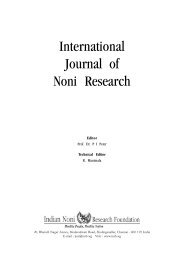International Journal of Noni Research - Noni Family
International Journal of Noni Research - Noni Family
International Journal of Noni Research - Noni Family
Create successful ePaper yourself
Turn your PDF publications into a flip-book with our unique Google optimized e-Paper software.
57 Intl. J. <strong>Noni</strong> Res. 2007, 2(1-2)<br />
D.R. Singh et al. Morinda citrifolia L. – An evergreen plant for diversification in commercial horticulture<br />
Salinity tolerance<br />
<strong>Noni</strong> is a highly salt tolerant tree that thrives in wet and dry conditions. There<br />
is a membrane enclosing a gel like substance around each seed enabling<br />
flotation, and the seed coating, being very hard and watertight, can delay<br />
sprouting for many months. The flower is self pollinating; so only one seed needs<br />
to sprout for a successful population to possibly emerge, these are positive traits<br />
for sea or air dispersion and colonization in any harsh conditions, from salt flats<br />
to lava flows. Influence <strong>of</strong> seawater inundation on vegetative growth <strong>of</strong> Morinda<br />
sp. after one year <strong>of</strong> planting indicates that the plants reached maximum height<br />
<strong>of</strong> 88.80 cm with 6-8 branches with first bud initiation 62 days after planting and<br />
fruit setting on 75 days after planting. An average yield <strong>of</strong> 1.10 kg fruits per plant<br />
was obtained. The soil pH was recorded to be varying from 6.18 to 8.28, EC from<br />
0.18 to 14.25 and the pH <strong>of</strong> water was recorded to be varying from 6.98 to 8.32<br />
and that <strong>of</strong> EC from 0.26 to 21.28.<br />
Irrigation with 75% sea water revealed luxuriant growth <strong>of</strong> Morinda citrifolia<br />
L. in respect <strong>of</strong> plant height (72.0 cm), stem girth (0.7 cm), number <strong>of</strong> leaves<br />
(52), in which EC was 13.26 dsm –1 and pH <strong>of</strong> 7.31 followed by 100 percent<br />
sea water which recorded plant height (70.0 cm), stem girth (0.7 cm), no. <strong>of</strong><br />
leaves (49) and the EC was 17.79 dsm –1 and pH <strong>of</strong> 7.63 whereas in control<br />
(normal water irrigation) the plants reached a height <strong>of</strong> 51.5 cm, stem girth <strong>of</strong><br />
0.5 cm and number <strong>of</strong> leaves was 51.5 in which the EC was 2.5 dsm – 1 and<br />
pH <strong>of</strong> 7.67. First bud initiation was recorded in 100% sea water within 361 days<br />
from the date <strong>of</strong> planting followed by 366 days in 75% sea water and in control<br />
was observed on 410 th days after planting.<br />
Gas exchange parameters<br />
Measurement <strong>of</strong> gas exchange parameters revealed that photosynthetic active<br />
radiation (1459 µmol/sq m /s), photosynthesis rate (27.8 µmol/sq m/s), stomatal<br />
conductance (75.54 µmol/mol), transpiration rate (2.48 million mol/sq m/s) and<br />
internal Co2 (654.04 k Pa) were recorded from plants growing under<br />
wasteland and plants growing under sea inundated and recorded photosynthetic<br />
active radiation (731.6 µmol/sq m/s), photosynthesis rate (26.70 µmol/sq m/s),<br />
transpiration rate (0.70 µmol/sq m/s), and internal CO2 (769.80 kPa).<br />
In sodium chloride (Nacl) irrigation experiment, the results revealed that<br />
rate <strong>of</strong> photosynthesis was maximum (7.90 µmol/sq m/s) in plants irrigated<br />
with 19.25 g Nacl/4 litre water whereas PAR was high (115.90 µmol/sq<br />
m/s) in plants irrigated with 26.25 Nacl / 4 litre water, rate <strong>of</strong> transpiration,<br />
stomatal conductance and internal CO 2 were recorded to be high (1.30<br />
µmol/sq m /s, 79.80 µmol/mol and 771.80 kPa ) in plants irrigated with<br />
normal water (control).








